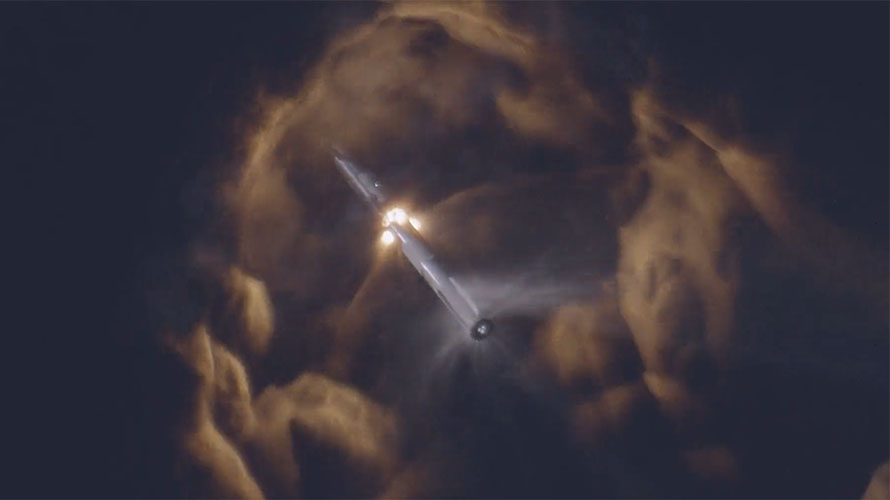Partially Successful Flight Reached Space and Demonstrated New “Hot Staging” System
The National Space Society congratulates SpaceX on the second test of its Starship/Super Heavy launch system. While the 400-foot (122-meter) vehicle did not complete all desired goals, the flight successfully tested the new launch complex and a new “hot staging” system, while checking off a number of other flight milestones. Notably, all 33 engines on the first stage ignited properly and continued firing for the desired duration, and after staging all six engines on the Starship upper stage ignited and pushed the vehicle close to orbital velocity.
Launching at 7 a.m. local time from SpaceX’s Starbase in Boca Chica, Texas, the Starship/Super Heavy system flew for just under nine minutes, reaching a maximum altitude of 91 miles (146.5 kilometers), substantially beyond the commonly defined edge of space—though the upper stage did not reach orbit before losing contact with the ground. Both stages ended up exploding. It has thus far not been announced if this was via activation of the FTS (Flight Termination System).
As noted, this flight tested SpaceX’s newly designed hot staging system, which allows the upper stage—Starship—to ignite before releasing the first stage. Initially pioneered by the Soviet Union and also used by the U.S. Titan rocket family, this is a first for SpaceX, and appeared to perform successfully. Hot staging significantly increases the payload delivered to orbit.

In the live webcast, SpaceX quality engineering manager Kate Tice said, “We’re going to take that data and improve the hot staging sequence and probably improve the hardware itself for the next flight.” The company had hoped to test reentry and landing processes by soft-landing the Super Heavy booster stage in the Gulf of Mexico.
“NSS eagerly anticipates Starship’s next series of successes and failures as SpaceX attempts to expand humanity’s horizons,” said Hoyt Davidson, NSS Executive Vice President. “Perfecting this kind of technology is very hard, and future failures are likely on the road to ultimate success. This is the price of human progress, and SpaceX is blazing new trails in this endeavor.”
With roughly twice the liftoff thrust of NASA’s Saturn V Moon rocket, the Starship system offers a substantially larger lift capacity than current heavy-lift rockets, and is the largest rocket ever designed and flown. Perhaps the most important aspect of Starship, however, is its intended full reusability, which promises to revolutionize the delivery of substantial payloads to orbit and beyond. A modified Starship is also being developed by SpaceX, and funded by NASA, to deliver astronauts to the lunar surface as a part of the Artemis program.
“Starship is an extraordinary program,” said Rod Pyle, Editor-in-Chief of the NSS quarterly magazine, Ad Astra, which covers space technology and achievements. “The intended reusability and frequent launch cadence of SpaceX’s megarocket will substantially impact—and likely improve—how we ‘do’ spaceflight. While much of the popular media highlights the explosions of the recent test flight, this is an integral part of SpaceX’s design and test philosophy. The implications of how Starship will change cislunar operations and, ultimately, the human settlement of space, cannot be overstated.”
While no firm future Starship launch dates have been announced, observers of the program have noted a number of Starship vehicles standing by at Starbase in Boca Chica. In a show of organizational competence, SpaceX also scheduled two other launches of its Falcon 9 rocket on the same weekend as the Starship test flight, one each from the east and west coasts of the U.S. One lofted Starlink Group 6-23 from Florida on November 18th, in the 85th launch by SpaceX this year. The second was planned to launch Starlink Group 7-7 from Vandenberg Space Force base the evening of November 19th but was delayed until the early morning of the 20th.
Images courtesy SpaceX.


















